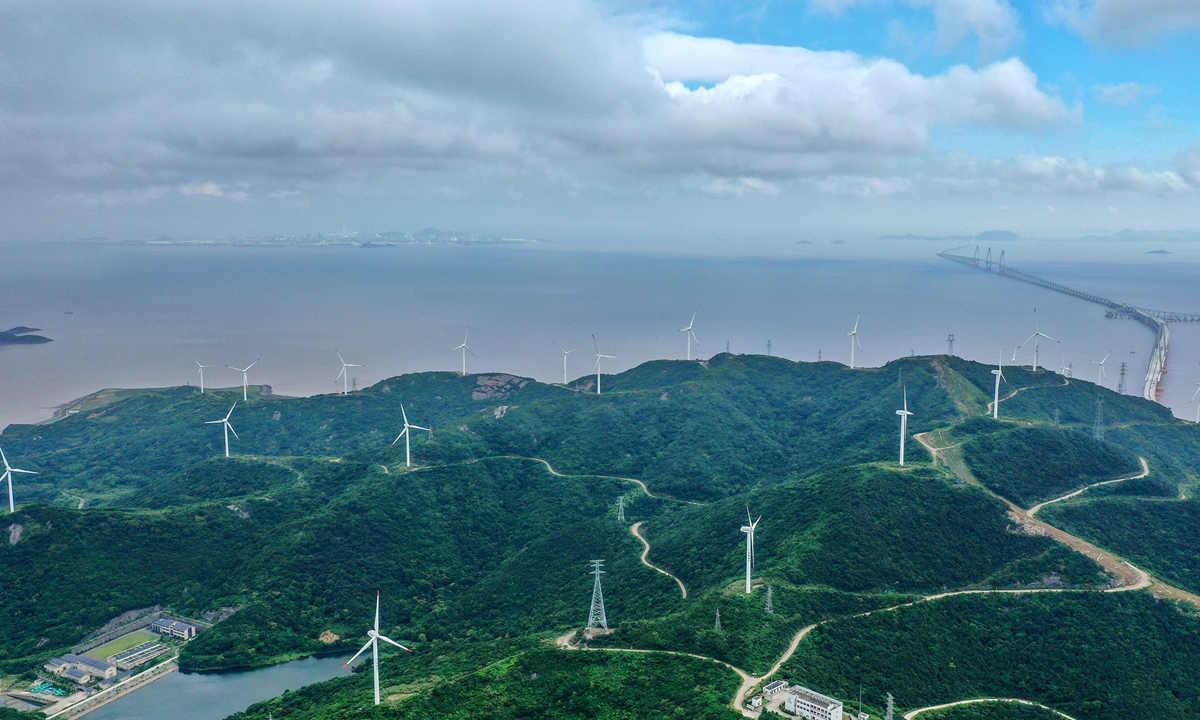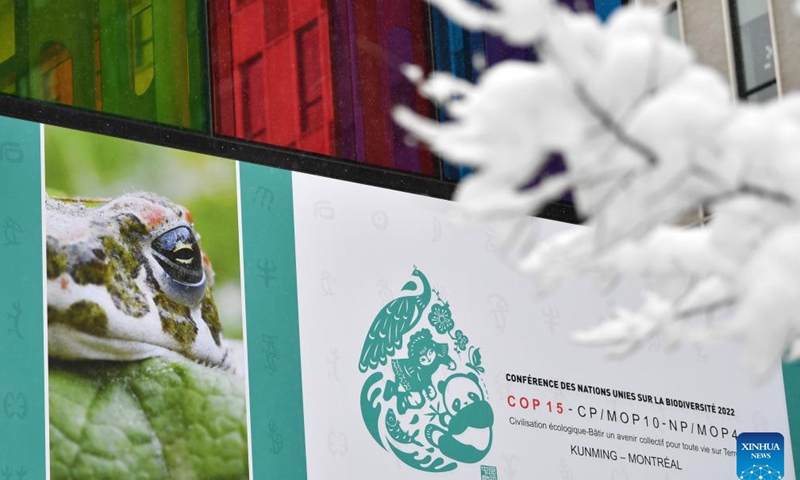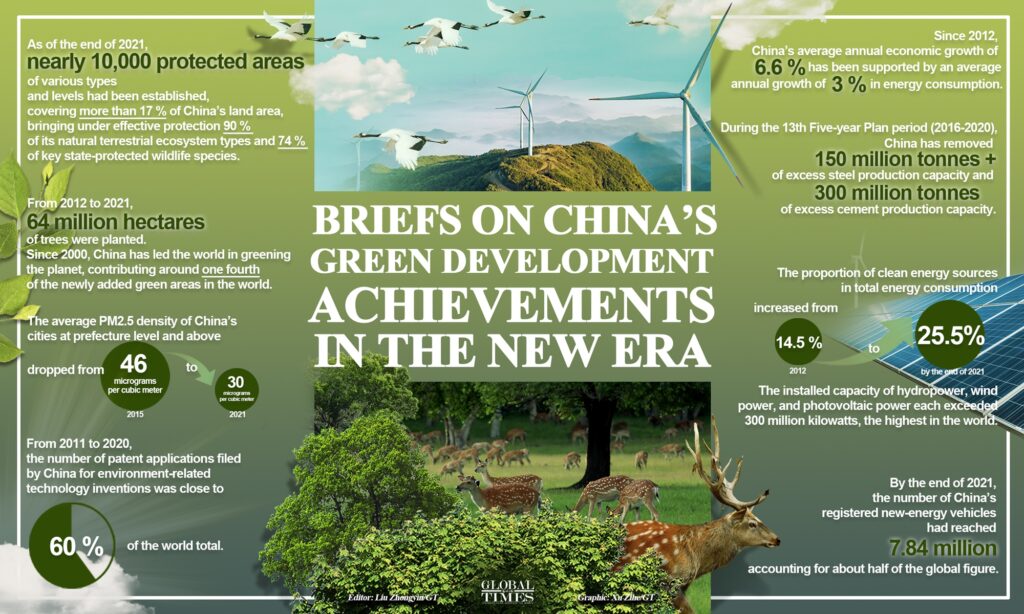China on Thursday released a white paper on its green development in the new era, elaborating on how the country has stayed firmly committed to green development, proactively participated in global climate governance and spearheaded international cooperation.
The white paper is issued at a time when the global prospect for climate cooperation remains murky amid a lingering energy crisis, with developed countries including the US and major European nations – among the largest greenhouse gas emitters in history – either derailing or flip flopping on their carbon promises, and pressing global environmental agenda being increasingly hijacked by some Western hegemonic powers and turned into their politicized tools to target China’s ascending global influence.
Despite the downside, China is not only embarking on lockstep toward its two carbon targets respectively in 2030 and 2060, but also actively helping the developing countries tackle climate issues via South-South cooperation, the white paper showed.
The slew of concrete moves is an embodiment of China’s commitments to the world as a responsible major power. More importantly, it sends both a resounding and encouraging message to the world, in the midst of chaotic global schemes and widened divisions, which observers said is set to inject new impetus to the global climate fight.
The white paper, titled “China’s Green Development in the New Era,” contains seven chapters, including China’s commitment to green development path, green territorial configuration, industrial structure’s further optimization, mechanism for green development and international cooperation outreach. According to the white paper, China, as the world’s largest developing nation, has made remarkable progress in green development and great contribution in the global arena.
As of the end of 2021, nearly 10,000 protected areas of various types and levels had been established, covering more than 17 percent of China’s land area, bringing under effective protection 90 percent of its natural terrestrial ecosystem types and 74 percent of key state-protected wildlife species, the white paper said.
From 2012 to 2021, 64 million hectares of trees were planted. Since 2000, China has led the world in greening the planet, contributing around one fourth of the newly added green areas in the world, it said.
China is also making the fastest progress in air quality improvement. The average PM2.5 density of China’s cities at prefecture level and above dropped from 46 micrograms per cubic meter in 2015 to 30 micrograms per cubic meter in 2021. A total of 87.5 percent of the days in 2021 have been good air quality days, according to the document.
The proportion of clean energy sources in China’s total energy consumption increased from 14.5 percent in 2012 to 25.5 percent by the end of 2021, while the proportion of coal decreased from 68.5 percent to 56 percent over the same period, the document said.
By the end of 2021, the installed capacity of renewable energy was more than 1 billion kilowatts, accounting for 44.8 percent of China’s overall installed capacity. The installed capacity of hydropower, wind power, and photovoltaic power each exceeded 300 million kilowatts, the highest in the world.
China “fully demonstrates its strong sense of responsibility as a major power… and helps build a fair, rational and mutually beneficial global climate governance system,” Zhao Chenxin, vice director of the National Development and Reform Commission, China’s top economic planner, said at a press briefing on Thursday.
China has made the solemn pledges to achieve carbon emissions peak by 2030, and carbon neutrality by 2060. That target, if achieved on schedule, will mark the world’s steepest reduction in carbon emission intensity and the shortest time in achieving the goal of going from carbon peak to carbon neutrality in global history, according to Zhao.

Wind turbines rotate as sea breezes flow through the Cengang Wind Farm in Zhoushan, East China’s Zhejiang Province. Photo: cnsphoto
China’s firm resolve
“The white paper underscores China’s unswerving determination to honor its commitment. Given the three-fold global pressures of energy crunch, food crisis and economic meltdown, it is an affirmation that China will not retreat from its global responsibility in coping with climate challenges, instead it is ramping up the role,” Lin Boqiang, director of the China Center for Energy Economics Research at Xiamen University, told the Global Times on Thursday.
It is also released at a time when China is gradually walking out of the clouds of epidemic, and needs a momentum to realize high-quality growth, and green development is one of the potential drivers, Pan Jiahua, director of the institute of eco-civilization studies of the Beijing University of Technology, told the Global Times on Thursday.
Observers said the stepped-up inputs by China will play a global exemplary role for both developing and developed worlds. On the one hand, developing countries could avoid detours and have a readily available shortcut. On the other hand, it serves as a timely reminder to certain developed nations not to dial back from their pledges.
“Developed countries with capitals, sources and aspiration could be encouraged to return back to the right track of development,” Li Haidong, a professor at the Institute of International Relations at the China Foreign Affairs University, told the Global Times on Thursday.
Unlike some Western countries’ flip-flop energy approach, China has shown consistency in its policy as it pursues a green path of development, which is borne out in the white paper. And such growth priority is further established by the tone-setting 20th National Congress of the Communist Party of China report in October, which expounded China’s overarching goal of modernization and identified the Chinese way of modernization as a new path of “harmonious co-existence between man and nature.” The white paper doesn’t disclose the amount of carbon emission reduction last year. But analysts expected that the amount being cut in 2022 was in parallel with the specific goals set before for each energy-intensive industry, such as steel, nonferrous metals and cement.
In breakdown, many of China’s detailed environmental indexes also championed the world.
China has also supported an annual economic growth averaged at 6.6 percent with an annual energy consumption at 3 percent, according to the white paper. Compared with 2012, China’s energy consumption per unit of GDP had dropped by 26.4 percent in 2021, making it one of the fastest countries in cutting energy intensity, according to the white paper.

A banner of the second phase of the COP15 is seen outside Montreal Convention Center in Montreal, Canada, Dec 17, 2022. Photo:Xinhua
West’s failure to live up to obligation
In global cooperation, China has also made historical contribution to the conclusion and implementation of the Paris agreement, actively participated in South-South cooperation on climate change, and advanced international cooperation on saving resources and protecting the eco-environment. And it is also working with other countries on promoting green development under the Belt and Road Initiative, Zhao said.
Pan said China has played a very active role in promoting and leading the building of a community with a shared future for mankind. Whether at the UN climate talks or COP15 at which world leaders adopted the historic Kunming-Montreal Global Biodiversity Framework, China has made undeniable contributions.
China’s pragmatic contribution in containing global warming runs a stark contrast to some Western countries, which analysts said do not fully face up to their historical responsibility, and always “trumpet aloud but lack of substantial steps.”
Li said that it is particularly ironic that the US, a long-time dominator of global affairs, takes a back seat in climate governance. “The US is the strongest power in the world whether in terms of economy or capital and technology, but it has always been a deserter in dealing with global climate change,” he noted.
To date, the developed countries’ pledge of $100 billion per year to developing nations remains unfulfilled, and there is no clear funding arrangement for the “loss and damage” fund set up during the COP27 summit.
During the COP27 summit that concluded in November, it is reported that Western countries, the main contributors to historical global greenhouse gases, were using the global platform to pressure China and other emerging economies to pay for the damage fund.
“The West has always played a double standard when it comes to addressing climate change and reducing emissions, being lenient with its own requirements but particularly strict with those of developing countries, especially China,” Li said.
This double standard has made the international community realize the hypocrisy and slackness of the West in developing green economy, but rather, trying hard to use emission targets as a political tool to blackmail or slow down the rapid development of China, Li noted, while urging the West to give up its prejudice toward China and facilitate pragmatic cooperation.
(Global Times)




